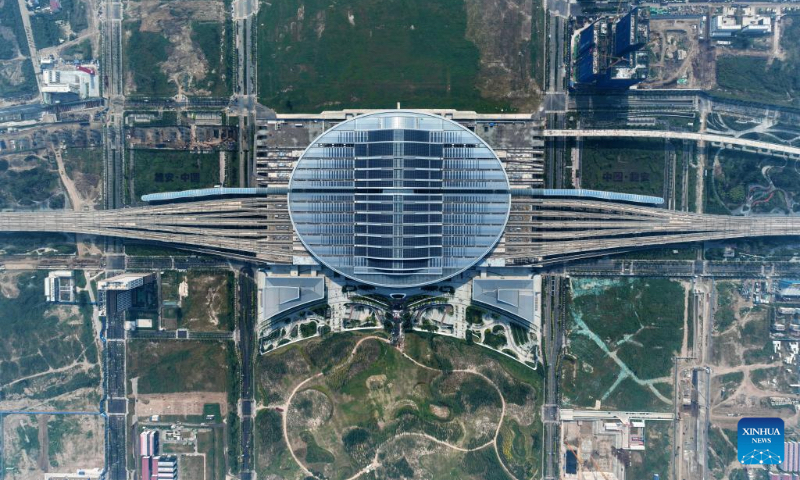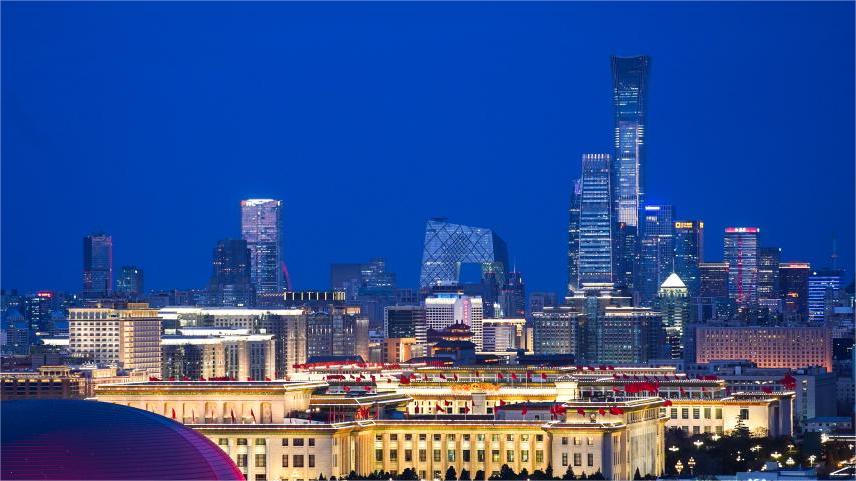Advanced technologies spur low-carbon lifestyle across China
Advanced green and low-carbon technologies have made their way in recent years to various industries in China, such as the construction, agriculture, and transportation sectors, empowering people across the country to enjoy eco-friendly lifestyles.
In China, the proportion of green building area in newly constructed area has exceeded 90 percent, according to Peng Shou, an academician of the Chinese Academy of Engineering.
Continuous breakthroughs in China's green building materials industry have constantly updated the industry's business forms, Peng said during a recent interview.
In Beijing’s Chaoyang district, a total of 20 energy-saving technologies of seven major categories have helped put an "energy-saving outfit" on a building constructed in 1987, making it Beijing's first zero-carbon building after renovation, and also a model of green buildings in the field of public building renovation.

Aerial photo taken on Sept. 9, 2022 shows the Xiong'an Railway Station in Xiong'an New Area, north China's Hebei Province. (Xinhua/Xing Guangli)
Relevant technologies have reduced the building's energy consumption to 66 percent of its pre-renovation levels, and various photovoltaic facilities installed on the surface of the building act as "energy collectors," providing sufficient electricity for the building, explained Gong Haiguang, director of the Beijing building energy efficiency research and development center.
Not long ago, the first zero-carbon office building in southwest China's Guizhou Province was put into use.
The building is equipped with two wind turbines, which are expected to generate 3,299 kilowatt-hours (kWh) of electricity annually. The utilization of shallow geothermal energy helps ensure heating in winter and cooling in summer for the building.
"Green buildings are an essential means of shaping green production and lifestyles, and driving industrial transformation and upgrading," Peng said, noting that the implementation of relevant policies has given China an advantage in the large-scale development of green buildings.
Low-carbon technologies have also deeply integrated into the country's agriculture sector, facilitating efforts to achieve a win-win situation for agricultural production and environmental protection.
In Huantai county, Zibo city, east China's Shandong Province, a low-carbon wheat field covering an area of 200 mu (13.33 hectares) has realized the goal of increasing yield while ensuring environmental protection by employing no-till farming and precision fertilization, among other methods of modern agriculture.
The wheat field is on a farm operated under the Modern Agriculture Platform (MAP) business model of Syngenta Group China, an agriculture giant owned by Sinochem Holdings.
Compared to traditional farming methods, these modern methods can increase the wheat yield per mu by about 7.5 percent, while reducing the use of agricultural machinery operations by two to three times, and cutting greenhouse gas emissions by about 30 percent, according to Jiang Yekui, chief sustainability officer of Syngenta Group China.
"To reduce carbon emissions, we adopted the no-till farming method from the start. Compared to traditional methods, this approach allows the soil to better fix carbon," Jiang explained.
"More precise water and fertilizer management is also a key measure to reduce carbon emissions. By adopting the method of formulated fertilization based on soil testing and management technologies in integrating water and fertilizers, we have been able to save water by 50 percent and fertilizers by 30 to 50 percent," Jiang added.
In many cities across the country, smart urban public transportation networks empowered by low-carbon technologies have paved the way for green travel.
Bus-hailing services and mobile charging robots, as part of such smart transportation networks, have brought tangible benefits to urban residents in many Chinese cities.
Zhu Tingting, a woman who works for a company in Xi'an city, capital of northwest China's Shaanxi Province, takes a "pre-ordered" shuttle bus from a subway station to her workplace every morning.
She places an order for the bus service on her mobile phone, and can get on the bus as soon as she gets out of the subway station, which has made commuting much more convenient, Zhu said.
Such "pre-ordered" shuttle buses, which reflects an innovative bus-hailing service Xi'an has launched to shape a diversified bus service system, allow citizens to enjoy "on-demand, economical, fast, order-based, and one-stop" bus rides, and have become the preferred choice for commuting for many people.
At a bamboo expo park in Anji county, east China's Zhejiang Province, a mobile charging robot saves owners of electric cars the trouble of waiting at or searching for charging piles themselves.
"In the past, car owners looked for charging piles to charge their cars. Now, charging piles look for vehicles that need to get charged," said Yu Xiang, vice president of China's electric vehicle charging service provider Newlink NaaS, adding that mobile charging robots have overcome the limitations of fixed charging piles in terms of site and battery capacity.
"Smart transportation has greatly optimized travel routes, promoted traffic safety, and facilitated energy conservation and emission reduction endeavors," said Wang Xianjin, vice president and chief engineer of China Academy of Transportation Sciences.
Smart transportation can contribute to China's efforts to realize its goal of peaking carbon dioxide emissions before 2030 and achieving carbon neutrality before 2060 on at least three levels, Wang noted.
First, smart transportation can integrate the resources of the transportation system and provide integrated transportation services, thus optimizing the structure of the transportation network; second, innovations and advancements in smart transportation technologies can bring significant changes to the entire industry, improving travel efficiency; and third, smart transportation technologies can ensure the accurate monitoring and measurement of carbon emissions across the transportation industry at relatively low social costs, providing a scientific basis for the formulation of relevant measures, he explained.
Photos
Related Stories
- Fine-tuned carbon trading regulation accelerates China's green transition
- What is the carbon footprint of producing an office chair?
- Scientists develop membrane that converts carbon dioxide to useful chemical
- China pilots carbon-peaking projects to explore new path to carbon reduction
- Scientists urge actions to reduce global forest fire carbon emissions
- With dual carbon goal and its own pace, China moving toward green transition
Copyright © 2024 People's Daily Online. All Rights Reserved.









